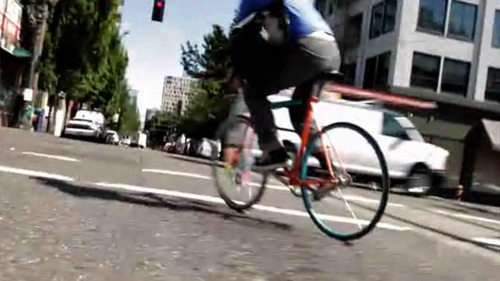
Portland, Oregon has been a bit of a punchline city in recent years, especially due to the popularity of IFC’s quirky TV show Portlandia, in which Fred Armisen and Carrie Brownstein make fun of the area’s quirky hipster characteristics. However, one thing the city is doing right is its growing emphasis on biking–Portland has the highest bike commuting share in the United States compared to all other major cities, and it’s working towards a goal of having a 25% bike mode share by 2030.
Tom Miller, director of the Portland Bureau of Transportation, cited a “crisis in transportation” as the reason for the department’s growing emphasis on biking and walking. The city, as with other major metropolitan areas, has a “21st century transportation vision” that officials are unsuccessfully trying to manifest with a “20th century funding model.” Obviously car commuting is more of a burden to the city’s budget than cycling or walking, but it’s refreshing to see Portland attempting to resolve their budget problems by embracing a solution that’s environmentally friendly and promotes exercise as well as being more fiscally sensible.
Also refreshing is Miller’s emphasis on transparency and accountability. He encourages Portland residents and bike advocates to keep track of the city’s progress with regards to bike commuting and hold the transportation department as well as elected officials accountable for any missteps or failures:
“If the funding is there, and you know the engineering expertise is there… The only thing we lack is political will.”
It’s a smart move if Miller wants to move the city towards his 25% bike mode share over the next 18 years. By keeping the public engaged and updated, they’ll become more passionate about the program and more interested in seeing the plan carried out. Public support will strengthen his position politically and can thus help him move his projects along better than if the public were to show disinterest or hostility towards his ideas.
Portland is setting a great example for other major cities. By investing in an alternate mode of transportation, the city is creating a better, healthier future for its residents and is also bringing awareness to bike and pedestrian safety. If more people start commuting via walking or cycling, there’s a better sense of “sharing the road” regardless of the transport method. People may snicker or roll their eyes at what’s thought to be a “hippie” city, but one thing that’s no laughing matter is how seriously Portland takes cycling and bike commuting. Save the chuckling for Portlandia and commend the city instead for their forward thinking.
Making Cities More Bicycle Friendly
Bicycle friendly cities are not just good for cyclists, they benefit everyone. A bicycle-friendly environment means safe, dedicated lanes, paths and roadways for cyclists, which can help reduce traffic congestion and improve air quality. Additionally, making cities more bicycle-friendly has numerous economic benefits, including increased retail activity and higher property values.
Here are some big reasons why cities should prioritize becoming more bicycle friendly:
- Stronger Economies: Bicycle tourism and the bicycle industry contribute $133 billion annually to the US economy. Portland, a Platinum-level Bicycle Friendly Community, saw $90 million in bicycle-related activity in just one year, with 60% of that coming from retail, rental and repair. Communities that prioritize biking also benefit from events, manufacturing, and professional services such as bike messengering.
- Increased Property Values: A 2006 study in Minneapolis found that home values rose by $510 for every quarter-mile closer they were to an off-street bikeway. Bike trails and facilities have a positive impact on home values.
- Increasing Local Retail Business: A study by San Francisco State University found that 66% of shops on Valencia Street reported improved business after the city reduced car widths and added bike infrastructure and wider sidewalks. In New York, tax revenue went up 20% in the second year after implementing a protected bike lane and pedestrian safety islands on Columbus Avenue. A congested South Bronx neighborhood saw a 50% increase in retail sales after making streets safer for cyclists.
- Attracting Talent: Bike-friendly communities are important for millennial job seekers. Communities that offer multiple transportation options are more attractive to this generation, which will make up 50-70% of the workforce in the next decade. Bike-friendly infrastructure helps companies attract top talent.
- Healthier People: Biking to work helps reach daily recommended physical activity, reducing the risk of chronic disease and unhealthy weight gain. A 2003 study showed that workplace physical activity programs can reduce short-term sick leave, health care costs and increase productivity. A Copenhagen study showed that bike commuters had 40% lower risk of dying and averaged a day fewer absences due to illness each year.
- Lower Healthcare Costs: Cycling for 30 minutes daily can save $544 per person in annual medical costs. A study found that if people completed half of their commutes of five miles or less by bicycle, the region could save $7.3 billion in health care costs and 1,100 lives would be saved annually.
- Safer Roads: Investing in bicycle infrastructure makes streets safer for all road users. High cycling cities generally show a lower risk of fatal crashes for all. Davis, CA, referred to as the “bicycle capital of America,” only had 9 fatal road crashes from 1996-2007 despite having the largest percentage of bike commuters in the US. Portland saw a nearly 50% decrease in road fatalities as its bicycle mode share increased from 1.2% in 1990 to 5.8% in 2000.
Challenges of Building Bicycle Friendly Cities
Making cities bicycle friendly is a major challenge, as it requires significant changes to urban infrastructure and transportation systems. One of the biggest challenges is accommodating bicycles and cars on the same roadways, which often leads to conflicts between drivers and cyclists. Another challenge is ensuring the safety of cyclists on busy roads, especially those with high-speed traffic. Cities need to provide bike lanes that are protected from traffic, as well as ensure that intersections are designed to be safe for cyclists.
Another challenge is the issue of parking and storage. Bicycle friendly cities need to provide secure bike parking options that are easily accessible to cyclists. This requires not only the provision of bike racks, but also the creation of bike storage facilities that are well-lit, safe and secure. Additionally, cities need to promote bike-sharing programs and bike rental services to make cycling more accessible to everyone.
It is also important for cities to address cultural and behavioral attitudes towards cycling. This involves education campaigns that encourage drivers to respect cyclists, as well as programs that encourage more people to take up cycling as a mode of transportation. Bicycle friendly cities need to be places where cycling is seen as a safe, practical, and enjoyable mode of transportation, and not just a leisure activity.



 AI-search
AI-search  Email
Email